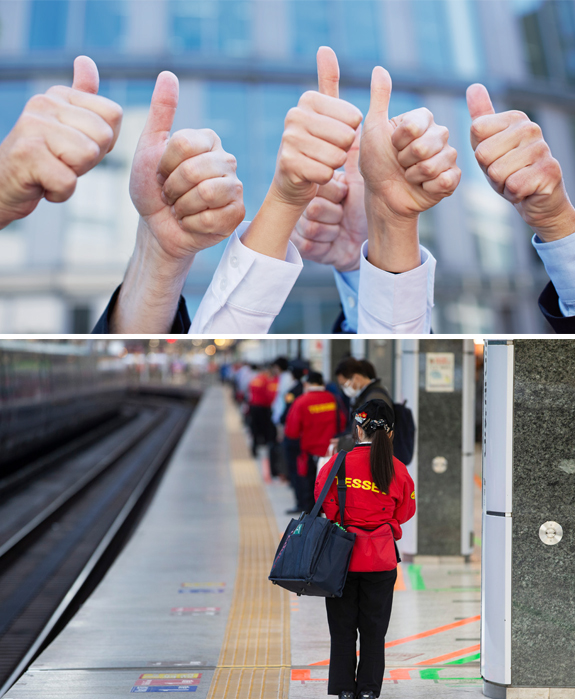Sustainable Growth of
a Company Depends On Its Members
Management scholars have summarized the recent environment that companies face as "VUCA," an acronym for "Volatility,
Uncertainty, Complexity, and Ambiguity," which are expected to grow further due to COVID-19. These changes
in the business environment are having a significant impact on the way companies survive.
It is the same reason why companies are calling for flexible management these days.
Based on flexible management, they seek to survive in the vortex of changes with nimbleness and legerity.
In such an environment, the members of the company became more important.
Uncertainty, Complexity, and Ambiguity," which are expected to grow further due to COVID-19. These changes
in the business environment are having a significant impact on the way companies survive.
It is the same reason why companies are calling for flexible management these days.
Based on flexible management, they seek to survive in the vortex of changes with nimbleness and legerity.
In such an environment, the members of the company became more important.

What companies came to value amidst such changes
General Electric (GE) has often been cited as the best example for improving the performance of an organization. The CEO of GE was called a management genius by introducing "the 10% rule," in which the top 20% are given bonus and opportunities for promotion, the middle 70% are encouraged to do better, and the bottom 10% are advised to resign. However, this system only pursues competition and performance and resulted in adverse effects by not responding to changes, causing talented individuals to leave, and hindering communication and cooperation.
As a result, the companies that thought sustainable growth was possible with clear goals and performances realized the importance of their members, where the possibility of sustainable growth depended on how the members thought of their organization and how they assume their roles for work. As management scholar Peter Drucker said, “The ultimate resource in economic development is people.”
These changes also changed the direction of goal and performance management. It started to change from Management by Objectives (MBO) to Objectives and “Key Results” (OKR). The purpose of OKR is to have the members design and plan the “Objectives” and “Key Results” for the objectives themselves, and manage sustainable growth and performances. It focuses on the process rather than the results.

Now, these changes have become irreversible, so organizations must create an environment in which the members’ feedback on the process can be made, and ensure that the continuous feedback and performance management based on the strengths of the members is done. To do this, you need three things: the first is “conversation,” in which the leader and members exchange various opinions; the second is “feedback,” in both ways between members; and the third is “recognition” equivalent to process-oriented acknowledgment and reward.
If a company can incorporate these into its culture, the members can also change. Management scholars Adam Grant and Ashford emphasize the importance of proactivity, saying that proactive members set active goals based on future-focused thinking, find various ways to achieve those goals, and makes different and innovative proposals outside their work routine to make meaningful changes in the organization. Ultimately, for an organization to change, employees must all change to create synergy.
If a company can incorporate these into its culture, the members can also change. Management scholars Adam Grant and Ashford emphasize the importance of proactivity, saying that proactive members set active goals based on future-focused thinking, find various ways to achieve those goals, and makes different and innovative proposals outside their work routine to make meaningful changes in the organization. Ultimately, for an organization to change, employees must all change to create synergy.

What happens when a company and its people change?
There is a case where the performance of a company greatly increased when its members changed. This is the case of Tessei, the cleaning company that cleans the Japanese high-speed train Shinkansen. This became a study titled “The 7 minute miracle” at Harvard Business School, and served as a model for many companies. When the new leader of Tessei took over, he tried a huge change. He found that the job was merely a means of living, and none of the employees had pride in their job. Naturally, people did not stay for long and the efficiency was very low.
The first thing that he did was to change the uniforms and the name of the job. He changed the uniforms to a brighter color, called the workers "cleanup angels," and made cleaning service become recognized as a refined service. The Shinkansen cleaning crew gave new meaning to the objective of “Giving the passengers gratitude and strong impressions as the performers of the Shinkansen Theater,” performance objective of “creating warm memories for passengers in seven minutes,” and behavioral objective of “refreshing, comfortable, and warm.” In addition, their working environment was improved by installing air conditioners in the rest areas, and a mutually complimenting culture called "angel note" was established.
As a result, the attitudes of the cleaning crew who used to mechanically clean the train changed amazingly. A team of 22 people was able to perfectly clean about 1,000 seats in 7 minutes. The key to creating a workplace where employees actually want to work was founded on the pride they had in the job. As a result of valuing, respecting, and caring for their work, the members displayed their full abilities.

How each member affects the organization?
Of course, not all organizations that have such a good culture perform well. It is never easy for all members to work together in harmony. In the book, "The Secrets of Highly Successful Groups," the experiment of the good apple and bad apple was cited. It experiments what effects behaviors of individuals have, targeting 40 groups tasked with start-up marketing.
A person called "A" is given a role to play the Jerk, Slacker, and Downer during meetings. When everybody comes in energized into the meeting, he acts quiet and puts his head down on the desk. Of course, he is not enthusiastic about the meeting. Most of the people in the group were affected by "A," and the atmosphere became heavy, and because they couldn’t come together, so the performance dropped. One would expect someone to come forward and be angry with him, but no one did. Some of them even acted like "A."
However, one group showed a different result. It was because this group contained a person that the other groups did not. He would gently ask "A," who is ruining the meeting, “What do you think?” or respond with positive feedback such as “That sounds like a nice idea,” even to bad ideas. Even with a jerk, the meeting produced good results, and delivered good performances. He didn’t even show off his influence, and in fact, the others didn’t realize what he was doing.
It is an experiment that shows how the "bad apple" that hinders communication and the "good apple" that harmonizes and cooperates, play a role in a team. In other words, one negative individual may have an adverse effect on a group, but if there is one person who has positive attitudes, even if it doesn’t show much, the group can still draw out satisfactory results. When there are members with good attitudes, the atmosphere can be completely reversed.
Southwest Airlines is a company always mentioned in customer-centered management. The most important aspect the company considers when hiring is the prospective employee's attitude. And they keep a constant watch over the members’ attitudes even after they are hired. This is to ensure that the desirable attitudes are clearly known and applied by the employees, and that they can be delivered throughout the organization.

The reason cooperation and communication between employees is necessary
The term "Multi Persona" is the order of the day. It refers to an individual with various identities and personalities. This social phenomenon has created a difference between the older generation and the millennial generation. According to a survey by the leadership company Guru People’s targeting 120 people in HR, 33% of the older generation answered that the most important thing was “work,” whereas 36% of the millennials said it was “work-life-balance.”
Two things are essential for these two groups with different priorities to work together. They are “cooperation” and “communication”. Especially, It was found that the cooperation ability was greater when people’s movements overlapped. This is why companies are building overlap zones to create opportunities for non-face-to-face communication or introduce human touch in these times where mutual communication is difficult due to the increase in remote work.
In the past, people who performed well in their tasks were considered to be capable persons, but in the smart work era, there is a limit to achieving results like this and being recognized in the organization. Now, a capable person is someone who can properly understand values, effectively utilizes such values, and one who is able to communicate and cooperate in various ways to apply them. These types of members can make their company develop and grow sustainably.
2021.11.01

